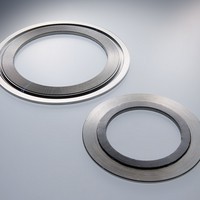Semi-metallic gaskets are specialized sealing components designed for high-performance applications where standard gaskets fall short. They combine metallic and non-metallic materials, offering superior strength, temperature resistance, and durability. These gaskets are essential in industries such as oil and gas, chemical processing, power generation, and automotive engineering, where they prevent leaks under extreme pressure and temperature conditions. The metallic elements provide structural integrity and resilience, while the non-metallic parts ensure flexibility and a tight seal. This hybrid design makes semi-metallic gaskets ideal for challenging environments, balancing the best properties of both material types to enhance safety and efficiency in mechanical systems.
Semi-metallic gaskets boast several distinctive features that set them apart from other gasket types. Their composite structure allows for excellent compression and recovery, meaning they can maintain a seal even after exposure to cyclic loading and thermal fluctuations. They exhibit high chemical resistance, making them suitable for corrosive media, and can operate in temperatures ranging from cryogenic levels up to 1000°C (1832°F), depending on the materials used. Additionally, these gaskets offer low creep relaxation, ensuring long-term sealing performance without frequent retightening. Their adaptability to irregular surfaces and ability to handle high bolt loads make them a preferred choice for critical applications where failure is not an option.
Understanding the technical parameters of semi-metallic gaskets is crucial for selecting the right product for your needs. Below, we detail the key specifications in a structured format.
Semi-metallic gaskets are crafted from a blend of materials to optimize performance. Common metallic components include stainless steel, carbon steel, or exotic alloys like Inconel, while non-metallic parts often incorporate graphite, PTFE, or ceramic fibers. The choice of materials depends on the application requirements, such as temperature, pressure, and chemical exposure.
Semi-metallic gaskets are available in various sizes to fit different flanges and connections. Dimensions are often standardized according to industry norms like ASME B16.20 or API specifications. Custom sizes can be manufactured based on client drawings or requirements.
| Nominal Size (inches) | Inner Diameter (mm) | Outer Diameter (mm) | Thickness (mm) |
|---|---|---|---|
| 1/2 | 15 | 35 | 1.5 |
| 1 | 25 | 50 | 2.0 |
| 2 | 50 | 100 | 2.5 |
| 4 | 100 | 150 | 3.0 |
| 8 | 200 | 300 | 4.0 |
These gaskets are rated for specific operational conditions. Key performance metrics include pressure rating, temperature range, and leakage class. Below is a table summarizing typical values based on common material combinations.
| Material Type | Max Temperature (°C) | Max Pressure (bar) | Leakage Class |
|---|---|---|---|
| Graphite with Stainless Steel | 500 | 100 | L1.0 |
| PTFE with Carbon Steel | 200 | 50 | L0.5 |
| Ceramic Fiber with Inconel | 1000 | 150 | L2.0 |
To ensure optimal performance, follow these guidelines when installing semi-metallic gaskets:
What are the main advantages of using semi-metallic gaskets over full metallic or non-metallic types?
Semi-metallic gaskets offer a balanced combination of strength and flexibility. Unlike full metallic gaskets, which can be rigid and prone to leakage on uneven surfaces, semi-metallic types adapt better due to their non-metallic components. Compared to non-metallic gaskets, they provide higher temperature and pressure resistance, making them suitable for more demanding environments. This hybrid design reduces the risk of blowouts and extends service life in cyclic conditions.
How do I select the right semi-metallic gasket for my application?
Selection depends on several factors: the operating temperature and pressure, the chemical compatibility with the media being sealed, the flange type and surface condition, and any regulatory standards required (e.g., API, ASME). Consult the material compatibility charts and performance tables provided by manufacturers, and consider conducting tests under simulated conditions if necessary. For critical applications, seek advice from engineering experts to ensure optimal performance and safety.
Can semi-metallic gaskets be reused after installation?
No, semi-metallic gaskets are generally designed for single use. Once compressed during installation, the materials undergo deformation to form a seal. Reusing them can lead to inadequate sealing, leaks, or failure due to reduced resilience and potential damage from previous cycles. Always replace gaskets during maintenance or reassembly to ensure reliability and prevent accidents.
What maintenance practices are recommended for systems using semi-metallic gaskets?
Regular maintenance includes visual inspections for signs of leakage, corrosion, or gasket degradation. Monitor bolt loads periodically and retorque if necessary, as bolts can loosen over time due to thermal cycling. Keep records of installation dates and conditions to schedule replacements proactively. Use appropriate cleaning agents that won't damage the gasket materials, and avoid exposing them to environments beyond their specified limits without proper evaluation.
Are semi-metallic gaskets environmentally friendly or recyclable?
The recyclability depends on the materials used. Metallic components like steel or alloys can often be recycled, while non-metallic parts such as graphite or PTFE may require special handling. Some manufacturers offer eco-friendly options with recyclable materials, but disposal should follow local regulations for industrial waste. Always check the material safety data sheets (MSDS) and consider end-of-life recycling programs to minimize environmental impact.
How do temperature fluctuations affect the performance of semi-metallic gaskets?
Temperature fluctuations can cause expansion and contraction in the gasket and flange materials, potentially leading to loss of bolt load and seal integrity. Semi-metallic gaskets are designed with materials that have good thermal recovery, meaning they can maintain a seal under cyclic conditions. However, extreme or rapid changes may require gaskets with specific thermal properties, such as those with flexible graphite fillers, which exhibit low thermal expansion and high resilience. Proper installation torque and periodic checks help mitigate issues related to temperature variations.






